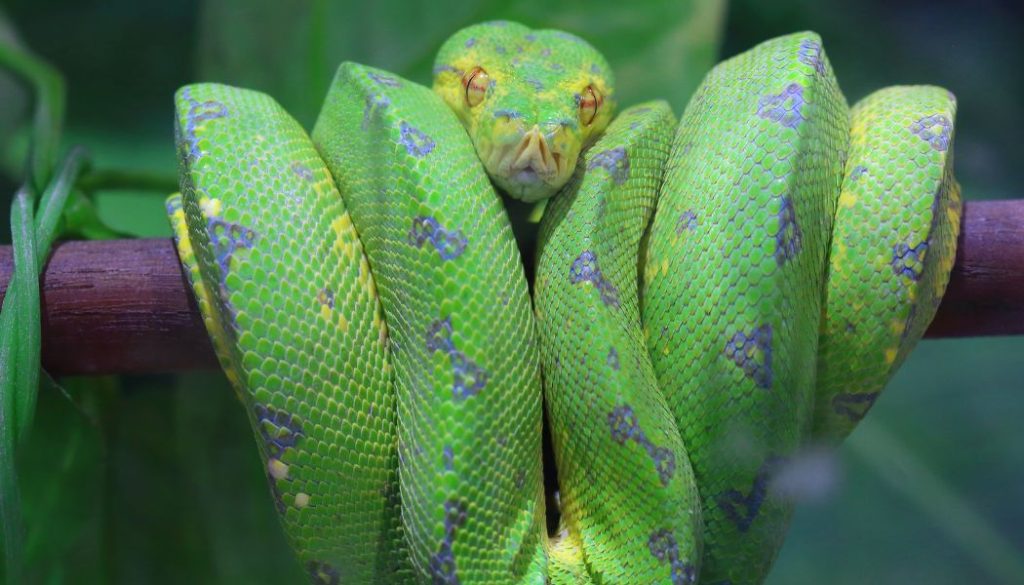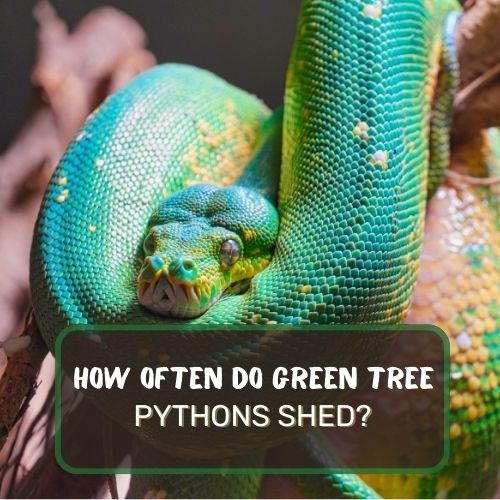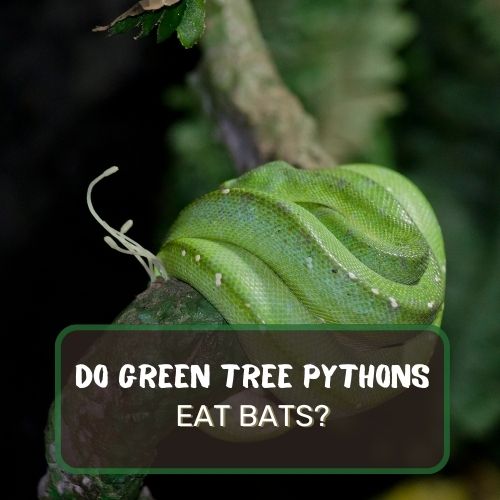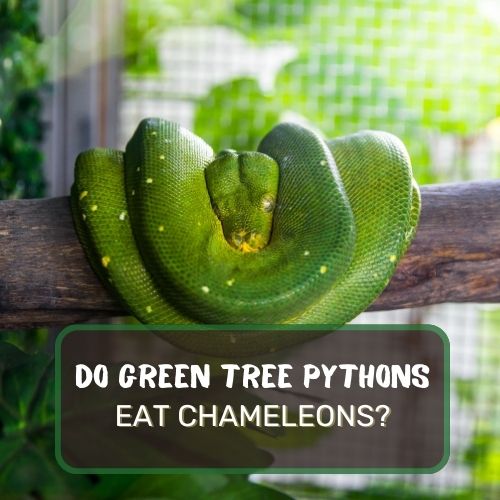Green tree pythons don’t change color on the fly like chameleons do. However, they do experience an ontogenetic color change as they grow older. Young pythons might start off as yellow, brown, or even red but usually transition to various shades of green as they mature.
This color change happens to improve their camouflage as they take on an arboreal lifestyle. So, while they undergo a significant color transformation early in life, their adult color remains consistent.
Ready to unravel the mystery of the ever-enchanting green tree python? You’re in for a treat! In this article, we dive deep into their stunning anatomy and reveal if these captivating creatures actually change color as popularly believed.
We’ll dissect the science behind it, explore the origins of the color-changing myth, and debunk some widely-held beliefs. Plus, we tackle the ontogenetic color change phenomenon and what really affects their hue.
Got questions? We’ve got answers in our FAQ section. So sit tight, it’s about to get colorful!

Table of Contents
Anatomy and Appearance
Let’s kick things off by talking about what green tree pythons actually look like. Trust me, these snakes are easy on the eyes!
Originating from Australia and Papua New Guinea, green tree pythons are known for their striking green scales and elegant, arboreal posture. They’re literally hanging art!
Now, picture this: A green tree python coiled effortlessly around a tree branch, almost like it’s one with the tree.
They usually have vibrant green scales that can range from bright lime to deep emerald, and these scales often have a mix of blue, yellow, and even white patterns that blend into a mesmerizing design.
It’s not just about looks, though. These colors serve as excellent camouflage against predators in their natural rainforest habitat. If you’re a bird flying over, good luck spotting one of these bad boys!
There’s more. They’ve got a triangular head and heat-sensitive pits around their mouths. Why? To detect prey, of course! These features make them remarkably unique and adapt them for a successful life in the trees.
Oh, and let’s not forget about their eyes: vertical-slit pupils, perfect for low-light vision.
So, that’s the deal on how they look. But do these captivating colors stick around for life, or are we witnessing some sort of reptilian magic trick? Let’s delve into the science behind it.
Scientific Facts: Do They Actually Change Color?
Ah, the million-dollar question: “Do green tree pythons change color?” It’s the sort of query that’s launched a thousand Google searches and possibly some heated debates between reptile enthusiasts.
So, here’s the tea, supported by good old scientific research.
First off, no, green tree pythons are not like your mood ring from the ’90s, changing colors according to their feelings. Nor are they chameleons, despite the popular myths.
These snakes do not have the physiological mechanisms to change their color at will. Science has shown that their coloration is due to various pigments and the structure of their scales.
However, there’s a plot twist. Young green tree pythons often start off as a different color entirely! They might be born yellow, brown, or even red. It’s only as they mature that they transition into the green hues we all associate with them.
This is known as ontogenetic color change. It’s like they go through a “reptile puberty,” if you will. Scientists believe this change happens to improve their camouflage as they grow and start living higher up in the trees.
So, while it’s true that green tree pythons undergo a significant color change as they grow up, they don’t change colors on a whim or at different times of the day. That whole chameleon comparison? Yeah, let’s put that to rest.
If you’ve heard claims about them changing color due to mood, diet, or environmental factors, it’s mostly speculation and not backed by scientific evidence.
To reiterate, green tree pythons have a fixed adult color that serves as their lifetime look. A green tree python is here to serve a look, and it’s committed to that look for life!
The Color Changing Myth: Where Did It Start?
Alright, let’s dish about this whole color-changing myth. I mean, it didn’t come out of thin air, right? The rumors that green tree pythons change color like chameleons probably started because, well, they’re just too cool not to talk about!
They already have this air of mystery around them, gracefully coiling on branches, looking like something straight out of a fairy tale or, dare I say, a sci-fi movie.
Combine that with their strikingly beautiful coloration, and you’ve got a reptile that’s begging for some folklore!
One possibility is that the myth started due to the real phenomenon of ontogenetic color change (more on that shortly, promise!).
Imagine being an observer and seeing a young, red or yellow python eventually become a gorgeous shade of green. If you didn’t know any better, you’d think, “Whoa, this thing must be changing colors all the time!”
Another angle comes from their care in captivity. Some snake enthusiasts have claimed to see their pythons’ colors “brighten” or “dull” based on various factors like mood or health.
But here’s the kicker: There’s no scientific evidence to support these claims.
So, while the origins of the myth are as elusive as the pythons themselves, it’s a mix of genuine biological change, misinterpretations, and maybe a sprinkle of human imagination.
The Ontogenetic Color Change
Oh boy, get ready for some science magic, people! Ontogenetic color change is the fascinating journey green tree pythons go through as they age, where they transition from a completely different juvenile color to their adult hue.
Think of it as their awkward teen phase, but instead of acne and questionable fashion choices, they get a whole new color palette!
When these pythons are born, they’re usually yellow, brown, or even a fiery red. Quite the opposite of green, right? The crazy part?
Scientists believe that the young pythons’ colors may help them blend in with their specific niche in the environment. The juveniles often hang out closer to the forest floor, where their original color helps them blend in.
But wait, there’s more! As they mature and become more arboreal (that’s a fancy way of saying they live in trees), they undergo this mind-blowing transformation into various shades of green. It usually happens between six months to a year of age.
This metamorphosis isn’t just for kicks; it serves a real purpose. Being green offers them better camouflage higher up in the trees, protecting them from predators and making them more effective ambush hunters.
What Affects the Color of a Green Tree Python?
Okay, so if green tree pythons don’t change color on a dime, what does affect their color? Great question! First off, genetics play a massive role.
Mom and dad pass down the genes that determine whether their baby python will grow up to be a lime green stunner or a deeper shade of emerald.
Then there’s age, as we’ve already covered. Juvenile green tree pythons are not green at all. It’s only when they go through their version of reptilian puberty, known as ontogenetic color change, that they turn green.
“But wait,” you might say, “I’ve heard their color can be affected by temperature or mood!” Well, those claims are shaky at best.
While it’s true that some animals have colors that respond to emotional or environmental changes, that’s not the case for green tree pythons.
Any observed changes are usually subtle and not enough to warrant the label “color-changing.” So, while factors like light exposure and health might affect the vibrancy of their color, they don’t actually “change” it in the way the myth suggests.
Debunking Myths: No, They’re Not Chameleons!
Alright, let’s put this baby to bed: Green tree pythons are NOT chameleons. They don’t have the special cells that chameleons have, called chromatophores, that allow for rapid color changes.
Chameleons are the rockstars of the color-changing world; they can change their hues in real-time in response to environmental cues or emotional states. Green tree pythons? Not so much.
Sure, they go through an epic color transformation as they mature, but once they’ve hit their stride in the green department, that’s pretty much it. They’ve found their look, and they’re sticking with it.
They don’t change color to communicate, they don’t change color to regulate their body temperature, and they most definitely don’t change color based on their mood.
So, let’s just appreciate green tree pythons for what they are: stunning, emerald beauties that have a fascinating life journey involving one significant color change. But chameleons, they are not.
And you know what? They’re pretty amazing just the way they are.
Conclusion
You’ve journeyed through the captivating world of green tree pythons, dispelling myths and diving into the science of their unique coloration.
Now you know that while they don’t change colors like a chameleon, their life does include a dramatic color transformation as they grow.
The myriad factors—from genetics to age—shape the radiant hues you see. You’re now armed with the facts, ready to appreciate these emerald wonders for what they truly are: nature’s masterpieces.
So the next time you encounter the subject, you’ll be the sage in the room! Keep exploring and stay curious; the natural world is full of surprises!
FAQ
So let’s tackle some of the most frequently asked questions, shall we?
What age do green tree pythons change color?
Most green tree pythons undergo their dramatic color change between six months to a year old. By the time they’re full-fledged adults, they’re sporting their signature green shade.
Can green tree pythons stay yellow?
Nope, they can’t just decide to stay yellow forever, as much as they might rock the look. Their color change is a natural part of their development.
Do red green tree pythons turn green?
Yes, indeed! Red juveniles eventually turn green as they mature. It’s like they’re going from playing the supporting role to being the star of the show!
Can green tree pythons stay red?
Just like with yellow, the answer is a resounding no. Red juvenile pythons will eventually transition to green. They can’t hang onto their youthful shades any more than we can hang onto our youth.




0 Comments